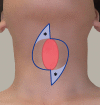Hinge Flap with Triangular Extension for Reconstruction of Pharyngocutaneous and Laryngocutaneous Fistulas
- PMID: 29464162
- PMCID: PMC5811292
- DOI: 10.1097/GOX.0000000000001630
Hinge Flap with Triangular Extension for Reconstruction of Pharyngocutaneous and Laryngocutaneous Fistulas
Abstract
Hinge flaps are commonly used for closure of a pharyngocutaneous fistula (PCF) or laryngocutaneous fistula. These flaps are employed to augment the wall of the pharynx or larynx, but the junction between the reconstructed and native lumens can eventually become narrow and irregular after reconstruction with standard hinge flaps. We devised a method of adding a triangular extension to the end of either or both flaps and used it to treat 3 patients. In 1 patient who developed a PCF (4 × 10 cm) after laryngectomy followed by radiotherapy, the fistula was closed with 2 hinge flaps. One flap had a caudal triangular extension. The residual skin defect was covered by a pedicled latissimus dorsi musculocutaneous flap. Another patient who developed a PCF (2.5 × 3 cm) after laryngectomy underwent 2-stage reconstruction using a buccal mucosal graft with a triangular extension, followed by 2 hinge flaps. A patient who developed an laryngocutaneous fistula (1 × 2 cm) after radiotherapy and subsequent partial laryngectomy underwent reconstruction using 2 hinge flaps, each of which had a triangular extension. The skin defect was covered by another flap. Postoperative CT or video fluoroscopic examination of swallowing showed a smooth lumen with no strictures in all 3 patients. The triangular extension of the hinge flap supplements the pharyngeal/laryngeal wall at the junction between the reconstructed and intact regions, thus avoiding postoperative stricture. Especially with PCF reconstruction, restoration of a smooth luminal surface minimizes dysphagia.
Figures



Similar articles
-
Pharyngocutaneous fistulas: management with one-stage flap reconstruction.Ann Plast Surg. 1986 Feb;16(2):125-35. Ann Plast Surg. 1986. PMID: 3273021
-
Pectoralis major myofascial interposition flap prevents postoperative pharyngocutaneous fistula in salvage total laryngectomy.Eur Arch Otorhinolaryngol. 2016 Nov;273(11):3943-3949. doi: 10.1007/s00405-016-4049-7. Epub 2016 Apr 23. Eur Arch Otorhinolaryngol. 2016. PMID: 27107580
-
Regional pedicled flaps in prevention and repair of pharyngocutaneous fistulas.Am J Otolaryngol. 2021 Sep-Oct;42(5):103119. doi: 10.1016/j.amjoto.2021.103119. Epub 2021 Jun 18. Am J Otolaryngol. 2021. PMID: 34175692 Review.
-
[CLINICAL APPLICATION OF PEDICLED THORACOACROMIAL ARTERY PERFORATOR FLAP FOR PHARYNGOCUTANEOUS FISTULA REPAIR AFTER RADIOTHERAPY AND SALVAGE TOTAL LARYNGECTOMY].Zhongguo Xiu Fu Chong Jian Wai Ke Za Zhi. 2016 Oct 8;30(10):1249-1252. doi: 10.7507/1002-1892.20160255. Zhongguo Xiu Fu Chong Jian Wai Ke Za Zhi. 2016. PMID: 29786205 Chinese.
-
[Pharyngocutaneous fistula as a complication after total laryngectomy--clinical study and literature review].Otolaryngol Pol. 2011 Sep;65(5 Suppl):22-30. doi: 10.1016/S0030-6657(11)70705-3. Otolaryngol Pol. 2011. PMID: 22000247 Review. Polish.
Cited by
-
Surgical treatment of tracheocutaneous fistula and tracheostomy scars using a hinged flap and local myocutaneous flap.Int Wound J. 2023 Sep;20(7):2499-2504. doi: 10.1111/iwj.14110. Epub 2023 Feb 2. Int Wound J. 2023. PMID: 36727609 Free PMC article.
-
Post Type 1 Thyroplasty Laryngocutaneous Fistula Repair at Vocal Cords Level with Deltopectoral Flap - A Rare Case Report and Review of Literature.Indian J Otolaryngol Head Neck Surg. 2024 Dec;76(6):5889-5892. doi: 10.1007/s12070-024-04959-3. Epub 2024 Aug 8. Indian J Otolaryngol Head Neck Surg. 2024. PMID: 39559023
References
-
- Padgett EC, Stephenson KL. Plastic and Reconstructive Surgery. 1948:Springfield, Ill.: Charles C Thomas Publisher; 628–639..
-
- Farina R. Pharyngoneoplasty. Br J Plast Surg. 1961;14:82–90.. - PubMed
-
- Lee UJ, Goh EK, Wang SG, et al. Closure of large tracheocutaneous fistula using turn-over hinge flap and V-Y advancement flap. J Laryngol Otol. 2002;116:627–629.. - PubMed
-
- Kamiyoshihara M, Nagashima T, Takeyoshi I. A novel technique for closing a tracheocutaneous fistula using a hinged skin flap. Surg Today. 2011;41:1166–1168.. - PubMed
LinkOut - more resources
Full Text Sources
Other Literature Sources
